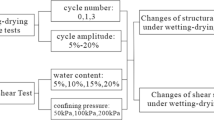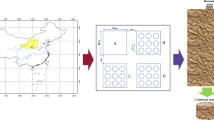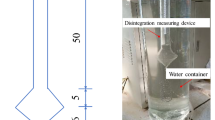Abstract
The strength and mechanical behaviour of loess are especially affected by water, and loess tends to disintegrate in the presence of water. Loess disintegration is closely related to the formation of caves, rills, and gullies on slopes and landslides. In this study, we conducted in situ tests and laboratory tests on Q3 Malan loess using self-developed disintegration instruments (small and large test blocks) to determine the characteristics and mechanisms of loess disintegration and their relationships with influencing factors such as initial water content, structure, curvature, and surface shape. The results show that the disintegration behaviour of loess conforms to a dynamic model. We propose that the fragmentation process and the breaking process are instantaneous and irreversible, whereas the separation process requires more time and is somewhat reversible. The disintegration time of the loess was controlled by the wetting velocity. An investigation of the boundary effect on the disintegration of the loess indicated that the presence of a disintegration nucleus was the result of slower water penetration of the inner layer caused by the temporary boundary confinement of the outer wetted layer. The boundary effect became more obvious with decreasing the water depth, increasing the curvature of the slot surfaces, and sharpening the edges of the convex upright in situ samples. The results of this study are intended to provide basic theoretical support for soil and water conservation and engineering construction in loess areas.



















Similar content being viewed by others
References
Annabi M, Houot S, Francou C, Poitrenaud M, Bissonnais YL (2007) Soil aggregate stability improvement with urban composts of different maturities. Soil Sci Soc Am J 71(2):413–423
Arkin Y (1988) Disintegration of marl slopes in Israel. Environ Geol Water Sci 11(1):5–14
Barden L, McGown A, Collins K (1973) The collapse mechanism in partly saturated soil. Eng Geol 7(1):49–60
Blanco-Canqui H, Lal R, Shipitalo MJ (2007) Aggregate disintegration and wettability for long-term management systems in the northern Appalachians. Soil Sci Soc Am J 71(3):759–765
Díaz AR, Sanleandro PM, Soriano AS, Serrato FB, Faulkner H (2007) The causes of piping in a set of abandoned agricultural terraces in Southeast Spain. Catena 69(3):282–293
Derbyshire E, Dijkstra TA, Smalley IJ, Li Y (1994) Failure mechanisms in loess and the effects of moisture content changes on remoulded strength. Quat Int 24:5–15
Derbyshire E, Kemp R, Meng X (1995) Variations in loess and palaeosol properties as indicators of palaeoclimatic gradients across the North China of North China. Quat Sci Rev 14(7):681–697
Derbyshire E (2001) Geological hazards in loess terrain, with particular reference to the loess regions of China. Earth Sci Rev 54(1–3):231–260
Emerson WW (1991) Structural decline of soils, assessment and prevention. Soil Res 29(6):905–921
Emerson WW (1994) Aggregate slaking and dispersion class, bulk properties of soil. Soil Res 32(2):173–184
Erguler ZA, Ulusay R (2009) Assessment of physical disintegration characteristics of clay-bearing rocks: disintegration index test and a new durability classification chart. Eng Geol 105(1–2):11–19
Faulkner H (2013) Badlands in marl lithologies: a field guide to soil dispersion, subsurface erosion and piping-origin gullies. Catena 106(3):42–53
Fuller ML (1922) Some unusual erosion features in the loess of China. Geogr Rev 12(4):570–584
Giménez RG, de la Villa RV, Martín JG (2012) Characterization of loess in Central Spain: a microstructural study. Environ Earth Sci 65(7):2125–2137
Heede BH (1971) Characteristics and processes of soil piping in gullies
Jones A (1971) Soil piping and Stream Channel initiation. Water Resour Res 7(3):602–610
Klukanova A, Sajgalik J (1994) Changes in loess fabric caused by collapse: an experimental study. Quat Int 24:35–39
Kruse GAM, Dijkstra TA, Schokking F (2007) Effects of soil structure on soil behaviour: illustrated with loess, glacially loaded clay and simulated flaser bedding examples. Eng Geol 91(1):34–45
Lado M, Benhur M, Shainberg I (2004) Soil wetting and texture effects on aggregate stability, seal formation, and erosion. Soil Sci Soc Am J 68(6):1992–1999
Levy GJ, Mamedov AI, Goldstein D (2003) Sodicity and water quality effects on slaking of aggregates from semi-arid soils 1. Soil Sci 168(8):552–562
Li XA, Huang RQ, Peng JB (2009) Experimental research on disintegration of loess. Chin J Rock Mech Eng 28(1):3207–3213 (in Chinese)
Liu T (1985) Loess and environment. Science Press, Beijing (in Chinese)
Liu Z, Liu F, Ma F, Wang M, Bai X, Zheng Y et al (2015) Collapsibility, composition, and microstructure of loess in China. Can Geotech J 53(4):673–686
Lutenegger AJ, Hallberg GR (1988) Stability of loess. Eng Geol 25(2–4):247–261
Lyles L, Disrud LA, Woodruff NP (1969) Effects of soil physical properties, rainfall characteristics, and wind velocity on clod disintegration by simulated rainfall 1. Soil Sci Soc Am J 33(2):302–306
Piccarreta M, Faulkner H, Bentivenga M, Capolongo D (2006) The influence of physico-chemical material properties on erosion processes in the badlands of Basilicata. Southern Italy Geomorphol 81(3–4):235–251
Peng J, Sun P, Igwe O (2018) Loess caves, a special kind of geo-hazard on loess plateau, northwestern China. Eng Geol 236:79–88
Pye K (1995) The nature, origin and accumulation of loess. Quat Sci Rev 14(7–8):653–667
Rogers CDF, Dijkstra TA, Smalley IJ (1994) Hydroconsolidation and subsidence of loess: studies from China, Russia, North America and Europe: in memory of Jan Sajgalik. Eng Geol 37(2):83–113
Roberts HM, Muhs DR, Iii EAB (2007) Loess records | north america - encyclopedia of quaternary science. Encyclopedia of quaternary Science, 1456–1466
Smalley I, Rogers C (1996) Loess: the yellow earth. Geol Today 12(5):186–193
Shi JS, Wu LZ, Wu SR, Li B, Wang T, Xin P (2016) Analysis of the causes of large-scale loess landslides in Baoji, China. Geomorphology 264:109–117
Sadisun IA, Shimada H, Ichinose M, Matsui K (2005) Study on the physical disintegration characteristics of Subang claystone subjected to a modified slaking index test. Geotech Geol Eng 23(3):199–218
Sharma K, Kiyota T, Kyokawa H (2017) Effect of slaking on direct shear behaviour of crushed mudstones. Soils Found 57(2):288–300
Standardization Administration of China (SAC), Ministry of Water Resources (1999) China National Standards GB/T50123–1999: standard for soil test method. China Planning Press, Beijing (in Chinese)
Sun P, Peng J, Chen L, Lu Q, Igwe O (2016) An experimental study of the mechanical characteristics of fractured loess in western China. Bull Eng Geol Environ 75(4):1639–1647
Tan TK (1988) Fundamental properties of loess from northwestern China. Eng Geol 25(2–4):103–122
Ternan JL, Elmes A, Fitzjohn C, Williams AG (1998) Piping susceptibility and the role of hydro-geomorphic controls in pipe development in alluvial sediments, Central Spain. Zeitschrift Für Geomorphologie 42(1):75–87
Vandekerckhove L, Poesen J, Wijdenes DO, Gyssels G, Beuselinck L, Luna ED (2000) Characteristics and controlling factors of bank gullies in two semi-arid Mediterranean environments. Geomorphology 33(1):37–58
Vermang J, Demeyer V, Cornelis WM, Gabriels D (2009) Aggregate stability and erosion response to antecedent water content of a loess soil. Soil Sci Soc Am J 73(3):718–726
Wang NQ, Wang QT, Xue Q, Liu XL (2014) Experimental study of static disintegration on unsaturated soil. Appl Mech Mater 580-583:68–72
Wang B, Zheng F, Römkens MJ, Darboux F (2013) Soil erodibility for water erosion: a perspective and Chinese experiences. Geomorphology 187:1–10
Wang X, Jin Z, Zhang X, Xiao J, Zhang F, Pan Y (2018) High-resolution geochemical records of deposition couplets in a palaeolandslide-dammed reservoir on the Chinese Loess Plateau and its implication for rainstorm erosion. Journal of Soils & Sediments 18(3):1–12
Zárate MA (2007) Loess records | South America. Encyclopedia of quaternary. Science 26(6):629–641
Zhang AG, Shan YJ, Jing XY (2003) The making and application of the soil erodibility index nomograph suitable for water-erosion region in China. J Mountain Res 5:016
Zhang MS, Liu J (2010) Controlling factors of loess landslides in western China. Environ Earth Sci 59(8):1671–1680
Zheng F, Wang B (2014) Soil erosion in the Loess Plateau region of China. In Restoration and development of the degraded loess plateau, China (pp. 77–92). Springer, Tokyo
Zhang XW, Kong LW, Chen C, Yin S (2016) Experimental investigation on relative contribution of hot and humid weather and heavy rainfall in disintegration of basalt residual soil. Sci Sinica 46(11):1175–1184
Zhu TX, Luk SH, Cai QG (2002) Tunnel erosion and sediment production in the hilly loess region, North China. J Hydrol 257(1):78–90
Zhu TX (2012) Gully and tunnel erosion in the hilly Loess Plateau region, China. Geomorphology 153-154(s 153–154):144–155
Acknowledgements
The authors sincerely acknowledge the financial support from the National Natural Science Foundation of China (grant nos. 41572264, 41172255, and 41440044).
Author information
Authors and Affiliations
Corresponding author
Rights and permissions
About this article
Cite this article
Li, XA., Wang, L., Yan, Yl. et al. Experimental study on the disintegration of loess in the Loess Plateau of China. Bull Eng Geol Environ 78, 4907–4918 (2019). https://doi.org/10.1007/s10064-018-01434-6
Received:
Accepted:
Published:
Issue Date:
DOI: https://doi.org/10.1007/s10064-018-01434-6




